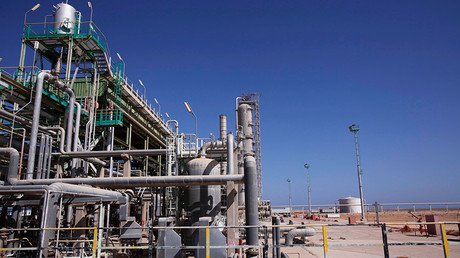Oil prices could double if Middle East conflict escalates

Barrel traders recently pushed the price of West Texas Intermediate (WTI) oil above $55; the first time in over two years.
Scarcity doesn’t really justify the upward price movement. There isn’t a shortage of oil in the world. But there could be, in the worst case, if missiles start flying between two of the world’s largest oil players: Saudi Arabia and Iran.
Maybe it won’t happen. But maybe it will. And that’s what the “geopolitical risk premium” is all about. It’s an anxiety surcharge that’s tacked onto every barrel of oil, in fear of supply disruption on a moment’s notice. And the fear is back.
After three years of naivety we’re back to acknowledging the known unknowns of the Middle East, the uncertainties that strap a 10-to-20 percent premium on the price of a barrel.
Paying a risk premium for oil is nothing new. It’s been around for decades and has gone up and down with the hostility thermometer of the Middle East.
Unusually, the pricing of risk dropped to zero around 2015. Three main reasons prompted a sense of world peace: the promise of the Iranian nuclear deal; a feeling that booming oilfields in Texas could offset any disruption; and a growing surplus of oil inventories in storage tanks around the world.
Of late, the notion of oil obsolescence has also perpetuated a feeling of nonchalance. “Who cares about the Middle East and their oil?” has been a question driven by the utopian narrative: “I’m not worried, everyone will be driving electric cars in a few years anyway.”
But it’s all been a false sense of security.
Electric cars are still rare. Oil remains vital to the world economy. Its geographic concentration is such that a large proportion of the world’s needs is produced from underneath layers of geopolitics, religious antagonism, authoritarianism, civil strife and corruption.
Saudi Arabia v Iran: What’s behind bitter feud between Middle Eastern powers? https://t.co/rrbQMhpHMJ
— RT (@RT_com) November 9, 2017
When I reflect on the extremes of oily politics, I pull out my old copy of Life Magazine from 1973, the year of the Arab oil embargo. Back then, in a rare moment of unity, Arabs came together to curtail oil shipments to the west, demanding that Israel cede lands it captured in the 1967 war.
I’m struck by the two-page spread showing a Dutch freeway that’s completely empty, not a car on the road due to widespread gasoline and diesel shortages. The disruption was less than three percent of world supply and lasted only a few months, but it was enough to momentarily paralyze transportation in affected countries—and change attitudes about energy security too. The fallout led to big changes in personal mobility—smaller cars, greater fuel economy and alternate modes of transport like high-speed rail—especially in Europe and Japan.
Juxtaposed on the fuel-starved image is a photo inset of a meeting between various leaders of the embargo. The snapshot is taken at a moment with lots of laughter, suggesting the not-so-subtle message that they were pleased with their destabilizing accomplishment. Maybe.
But no one is laughing now. Regional animosity is elevated, the weaponry is lethal and it’s hard to figure out allegiances and regional political ambitions. And the scale of consequence is bigger too: In 1973 oil consumption was almost 56 million barrels a day. Today it’s pushing 100 million bpd, with a quarter flowing through the Strait of Hormuz, a narrow, strategic chokepoint between Saudi Arabia and Iran.
The geopolitical premium is likely to increase over the next year. Oil markets are slowly heading back towards what OPEC calls “balance” and global inventories are gradually draining. The calculus is pretty simple: Progressively thinner margins for error, plus greater risk of disruption, equals more volatile prices to the upside.
If oil supply is pinched again, for whatever machination or military operation, the price of a barrel could easily double (prices quadrupled as a result of the 1973 embargo). And 20 years from now we may look back at a magazine spread of a freeway, this time showing a handful of cars—only the electric variety.
Higher oil prices are generally welcomed by petroleum producers and their upstream stakeholders. Yet amplified volatility and the potential of another oil crisis is a greater friend to purveyors of electric vehicles; they are the natural beneficiaries to their rival’s instability.
This article was originally published on Oilprice.com














